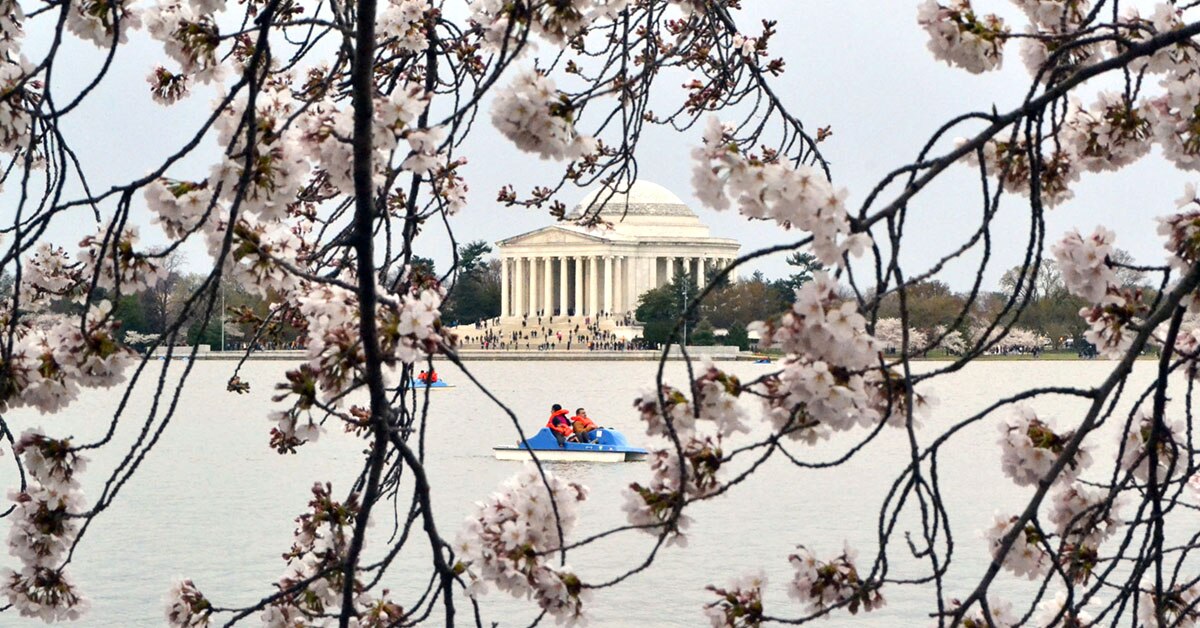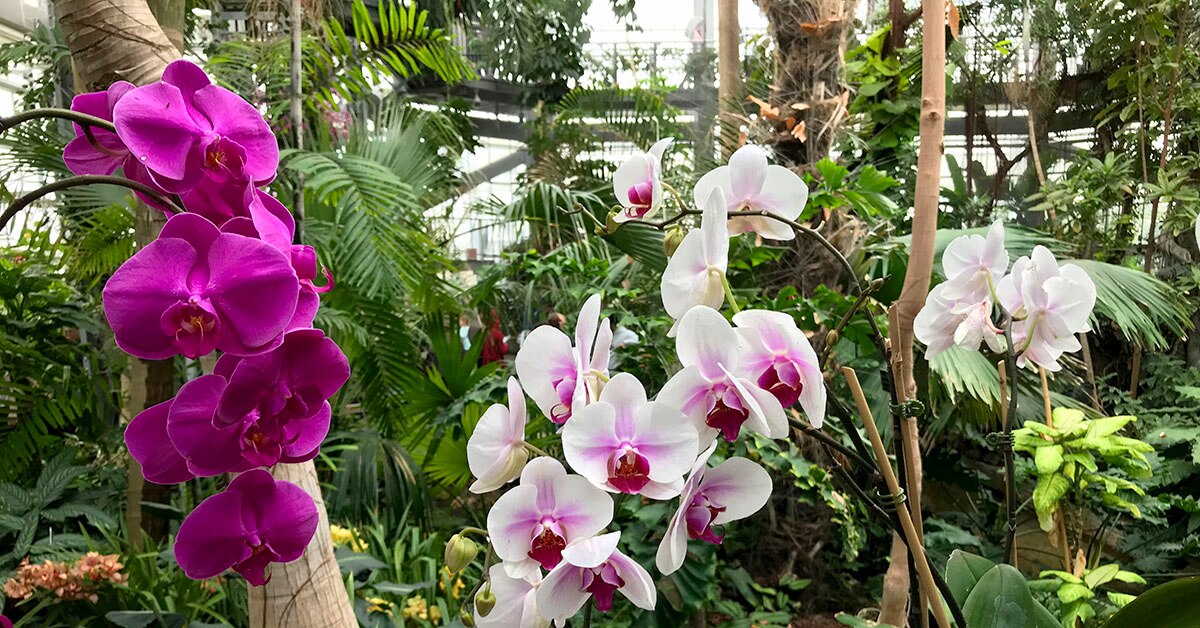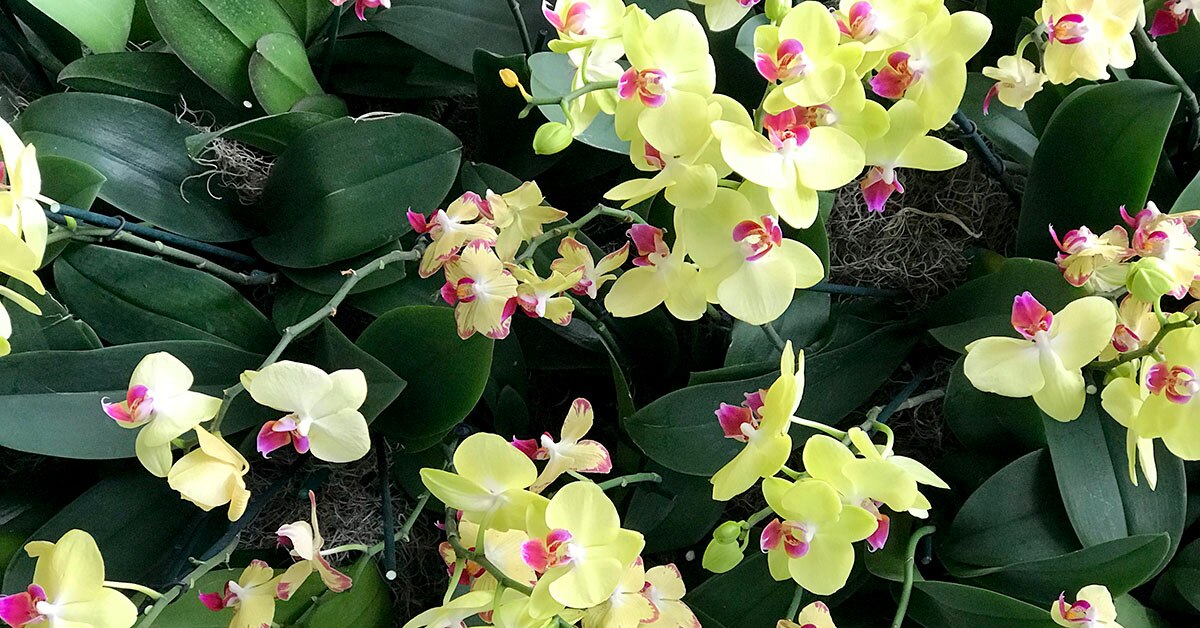Washington, D.C., Blossoms in Springtime

Yellow orchids. Photo by Lauren Kafka
Story by Lauren Kafka; photos by Alexander C. Kafka
Lauren is a writer and editor based in Bethesda, Maryland. Her husband, Alex, is a journalist, photographer and composer.
Enjoy the vibrant colors of the city at one of these scenic spots.
Imagine flipping a switch one day and opening your eyes to electric yellow forsythias, crisp blue hyacinths and soft pink peonies. Welcome to springtime in Washington, D.C. Although the capital may be better known for iconic historic monuments, stimulating free museums and rowdy political marches, it’s also a breathtaking place to celebrate the end of a cold, gray winter and the unfolding of a radiant, colorful spring.
The famed cherry trees lead the way with their late March or early April blooms. In 1912, Viscountess Iwa Chinda, wife of the Japanese ambassador to the United States, presented more than 3,000 flowering cherry trees to first lady Helen Taft as a gift and an annual symbol of friendship between the two countries. Tourists flock to the Tidal Basin and myriad locations throughout the city to take pictures of the blossoms, but natives know they are just the opening act to a season awash in dramatic hues.

The Jefferson Memorial is seen through cherry blossoms across the Tidal Basin.

Cherry blossoms bloom at Dumbarton Oaks in Georgetown.
Dumbarton Oaks
1703 32nd St. NW
Washington, DC 20007
202-339-6401
In 1920, Mildred and Robert Woods Bliss purchased a country house and garden on a 53-acre property at the highest point of Georgetown. After they hired landscape gardener Beatrix Farrand to design the gardens, which overlook both Rock Creek Park and Dumbarton Oaks Park, Mildred Bliss and Farrand collaborated for almost 30 years to turn their vision of terraced gardens, romantic orchards, peaceful meadows and wooded pathways into a reality.
Until Dec. 16, 2018, you’ll notice some striking concrete, stone and mosaic sculptures made with sticks and vines, which are mixed-media installations by Washington, D.C., artist Martha Jackson Jarvis. You’ll also see her temporary installation of bamboo harvested in the garden and embellished with found objects. The exhibition title, “Outside/In,” alludes to the fact that Jarvis’ work spans both outdoor and indoor spaces. Her earthy paintings in the museum, on display until Aug. 19, combine plant imagery with abstract forms.
Save some time to go inside the museum to see the Blisses’ outstanding collection of Byzantine and pre-Columbian art as well as the Renaissance-style music room designed to display their European furniture and tapestries — and serve as a space for music performances and scholarly gatherings. Postmodern architect Philip Johnson designed the distinctive space for the pre-Columbian collection, and the music room is a delightful place to hear chamber music on Sunday and Monday evenings from October through April.

The Japanese Garden at Hillwood Estate
Hillwood Estate, Museum & Gardens
4155 Linnean Ave. NW
Washington, DC 20008
202-686-5807
An equally charming location is Hillwood Estate, Museum & Gardens, home of Marjorie Merriweather Post (1887-1973), heir to the Postum Cereal Company, later General Foods, and one of the wealthiest women of her era. In 1955, Post purchased Hillwood as her spring and fall residence. During the winter, she escaped to Mar-a-Lago, the 126-room Palm Beach, Florida, mansion she built in the 1920s.
Highlights of Hillwood include the Japanese-style garden, a hybrid of Japanese and American plants as well as a cascading waterfall and picturesque pond; the French Parterre, with low, intricate plantings divided by footpaths and surrounded by walls of English ivy; the Lunar Lawn, where Post hosted receptions and garden parties; Friendship Walk, a footpath flanked by boxwood, rhododendrons and azaleas; the Greenhouse, which contains a spectacular collection of exotic orchids as well as tropical plants; and the peaceful, enchanting Rose Garden.
You’ll also see Post’s Putting Green, where she and her family and friends worked on their golf game. Be sure to tour the mansion, as well, where you’ll see the most comprehensive collection of Russian imperial art outside of Russia and an impressive collection of French art from the 1700s. If you need a bite to eat, the Hillwood Café offers lunch from Tuesday through Sunday.

A tree-lined lawn slopes down from Hillwood Estate.

The Botanic Garden has about 4,000 orchid plants representing more than 900 species. Photo by Lauren Kafka
U.S. Botanic Garden
100 Maryland Ave. SW
Washington, DC 20515
202-225-8333
If you’d like to see some jaw-dropping orchids, duck into the U.S. Botanic Garden, a gem envisioned by George Washington more than 200 years ago. The garden, established by Congress in 1820, maintains about 65,000 plants for exhibition, study, conservation and exchange with other institutions.
The orchids, about 4,000 plants representing more than 900 species, are many photographers’ favorites, but don’t miss the exhibits on Mediterranean plants, world deserts, Hawaiian species, rare and endangered plants, medicinal plants and the children’s garden, where kids can explore, dig and learn. The Botanic Garden also offers free programs, including cooking demonstrations, yoga classes, gardening presentations, tours of medicinal and poisonous plants and opportunities to meet botanical artists.

The National Bonsai & Penjing Museum at the National Arboretum
U.S. National Arboretum
3501 New York Ave. NE
Washington, DC 20002
202-245-2726, recorded information
202-245-4523, information desk
The National Arboretum, which sprawls across 446 acres and includes 9.5 miles of winding roadways, is famous for its azalea collection, which peaks in early May along with dogwoods and roses. The azalea bloom, a Washington favorite, is what prompted the arboretum to open its doors to the public in 1949. This dazzling display in early spring features about 2,000 plants on the Mount Hamilton hillsides.
Other crowd-pleasers at this magnificent attraction include the Asian Collections, Flowering Tree Walk, National Herb Garden and the National Bonsai & Penjing Museum, a unique indoor/outdoor display in three distinct pavilions, each complemented by its own meditative garden. A favorite photo spot is in front of the National Capitol Columns, 22 sandstone Corinthian columns that once stood on the east portico of the U.S. Capitol.
If you have time to spare in the evening, you can take a brisk, guided, two-hour hike through moonlit gardens, meadows and woods. Sensible shoes are recommended for the full-moon hike, as is early registration at hike@fona.org. The arboretum also hosts an annual cocktail reception fundraiser followed by dinner under the stars in early June when the gardens are in full bloom. For more information, email cathy@fona.org or call 202-544-8733.

The National Arboretum has sandstone columns that were originally part of the Capitol's East Portico.
Related
Read more stories about Washington, D.C.
- How to Judge Barbecue
- Barbecue Judge Picks Favorite Spots in Washington, D.C., area
- College Road Trip
- Judging Barbecue in Washington D.C.
- Weekend Getaway to Experience Washington, D.C. Serenity


